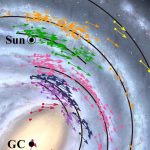Key Takeaways:
- Astronomers have detected a peculiar radio signal from a distant galaxy that exhibits a rhythmic, heartbeat-like pattern, in stark contrast to typical fast radio bursts (FRBs) that last mere milliseconds.
- This unique signal, known as FRB 20191221A, endured for several seconds with precisely repeating radio wave peaks every 0.2 seconds, resembling a cosmic heartbeat.
- While the origin of this enigmatic signal remains uncertain, neutron stars, specifically pulsars and magnetars, are the leading suspects, although the signal’s exceptional brightness raises questions about its source’s environment.
- The CHIME radio telescope has observed various FRBs, offering insight into their diverse properties and suggesting turbulent conditions in the vicinity of FRB 20191221A.
- This discovery opens new avenues for understanding the universe’s most mysterious signals, inviting further exploration into the cosmic origins of these peculiar radio bursts.
Astronomers have recently stumbled upon an extraordinary celestial occurrence – a radio signal emanating from a distant galaxy that pulsates rhythmically, akin to the steady beating of a heart. This peculiar signal, designated FRB 20191221A, diverges dramatically from the typical fast radio bursts (FRBs) which are fleeting, lasting mere milliseconds.
These FRBs, often dubbed ‘cosmic one-hit wonders,’ occasionally repeat either erratically or in a predictable manner. In the relatively short decade since their discovery, astronomers have documented hundreds of these intriguing phenomena.
However, the FRB observed by a team of astronomers employing the CHIME radio telescope stands out as a true cosmic oddity. While all known FRBs are characterized by their brevity, this particular signal lasted for several seconds, with an unprecedented periodicity – repeating its radio waves every 0.2 seconds, resembling a cosmic heartbeat.
According to Daniele Michilli, lead author of the study, “It was unusual. Not only was it very long, lasting about three seconds, but there were periodic peaks that were remarkably precise, emitting every fraction of a second – boom, boom, boom – like a heartbeat. This is the first time the signal itself is periodic.”
The intriguing question that follows is the origin of this extraordinary signal. Despite its uniqueness, the researchers speculate that a neutron star, the prime suspect behind most FRBs, is the likely source. This mysterious signal, however, shines over a million times brighter than any emissions previously observed from pulsars or magnetars in our Milky Way galaxy.
The hypothesis is that the signal might have originated from a pulsar or magnetar that typically remains much dimmer but momentarily discharged a burst in our direction. This tantalizing possibility suggests a complex cosmic environment around this enigmatic source.
Daniele Michilli emphasizes, “CHIME has now detected many FRBs with different properties. We’ve seen some that live inside clouds that are very turbulent, while others look like they’re in clean environments. From the properties of this new signal, we can say that around this source, there’s a cloud of plasma that must be extremely turbulent.”
This discovery paves the way for further exploration into the universe’s most perplexing signals, providing an opportunity to unravel the enigma behind FRBs and, potentially, offer fresh insights into the cosmic processes at play in our vast and mysterious cosmos.
The research was published in the journal Nature.


